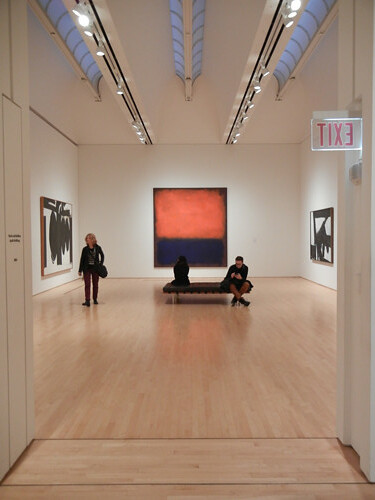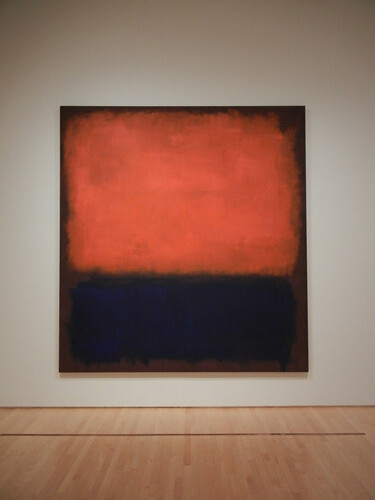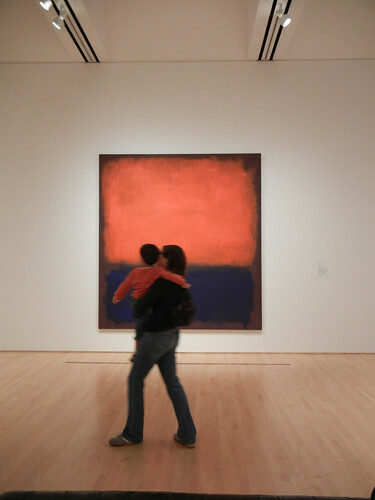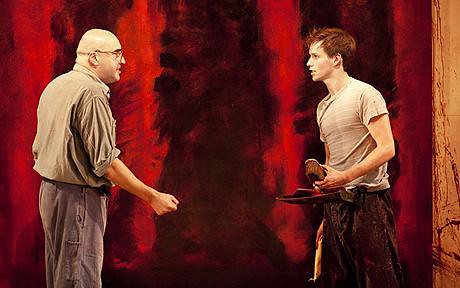
Last week, I saw the wonderful production of John Logan's award winning play, "Red", at Berkeley Repertory Theatre's, and was deeply impressed and moved by the presentation of the struggle of the great Latvian-American (sometimes referred to as Russian-American) abstract painter Mark Rothko, born Marcus Rothkowitz (Latvia (Dvinsk, [now Daugavpils], Latvia, September 25, 1903 - February 25, 1970, New York City, New York), while interacting, scolding, tutoring his young assistant. Berkeley Rep's website described the play as such:
At the height of his fame, Mark Rothko struggles in his studio to finish a major series of murals. The brilliant master wrestles with his new apprentice in a battle of wits over a bucket of paint.The play was very intense and witty and there were many things to savor.
First, I was most impressed by the philosophy behind Rothko's approach to art. He insisted on that a person had to be civilized to become an artist. That mantra was definitely a rebuke to our era when every trivial object, every thoughtless person could style himself as an artist. His disdain for the pop art scene, though too severe, was not without merit. Capturing zeitgeist was not unimportant, but true art needs to build beyond the mere reflection.
The depiction of Rothko's struggle - a great man's tussling with mundane life and to secure and preserve his posterity, his relevancy - was also well managed though a bit conveniently constructed.
Another main theme of the play - invented by the playwright - respect but bury the fathers, gave the play an air of a Greek tragedy. Speaking of tragedy, I was not very convince by the device in the form of the assistant's family tragedy; however, it didn't bother me and both actors, being so immersed in their challenging roles, ensured that even as a device, it was integral facade of the play.
There was a very physical scene, when Rothko and his assistant primed a huge canvas, to the beats of the energetic symphonic music. Paints spattered everywhere and I felt that at that moment, I was feeling the pulse of a great artist. It was very gratifying to see his painting process, even though it was only the initial step. If his energetic action here could be seen as joyous, when he faced more advanced canvas, at times, he was obviously struggling and that was precisely why his works were moving. He wanted to present some ideas, some visions, instead of doing it for his own pleasure and meditation.
Though the actors were very physically active, the supremacy of the play was the words, which made this play an oasis after a spate of over-produced, hyper-kinetic productions. It was through words, uttered with great intensity and clarity, that we peeped into the innermost of Rothko.
Living in the San Francisco Bay Area, I have been able to see Rothko's works many times, in Oakland Museum of California, Berkeley Art Museum, and San Francisco Museum of Modern Art (SFMOMA).
Below are a series of pictures I took at SFMOMA, in front of Rothko's "No. 14, 1960", 1960, Oil on Canvas, 114 1/2 in. x 105 5/8 in. (290.83 cm x 268.29 cm). It is deceptively simply yet rich with sub-contents. Its palette is delightful. It's both monumental huge and invitingly intimate, even a child loved it:



Below are a couple of images from this play's Tony-winning New York City run:







I agree that true art goes beyond mere reflection. And I would agree that what was exciting in this play/production was the language ... but as I read the script afterward it struck me how easily this play could fall flat if it weren't carried by a strong, convinced and convincing characterization by the actor who plays Rothko. Lucky for us, the Berkeley Rep's production provided exactly that.
ReplyDeleteI do agree that a good physical production is essential, however good the play itself might be. That's the reason we go to live theaters, instead of just reading the written play scripts.
ReplyDelete